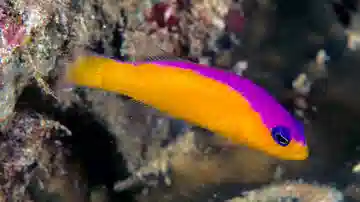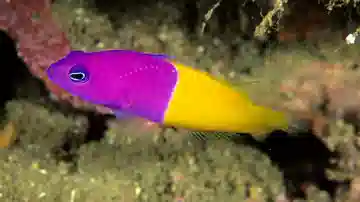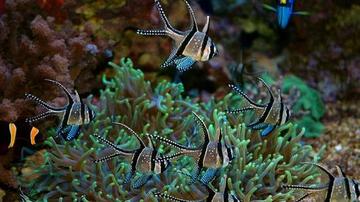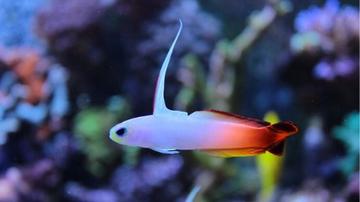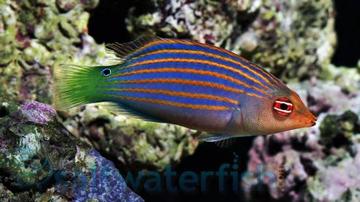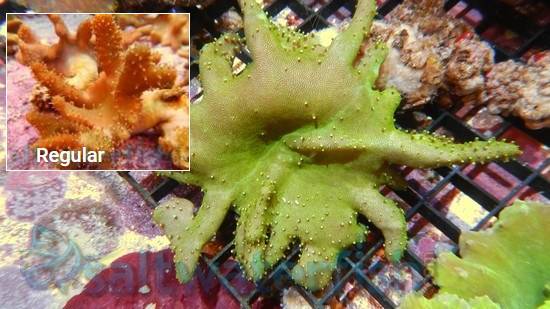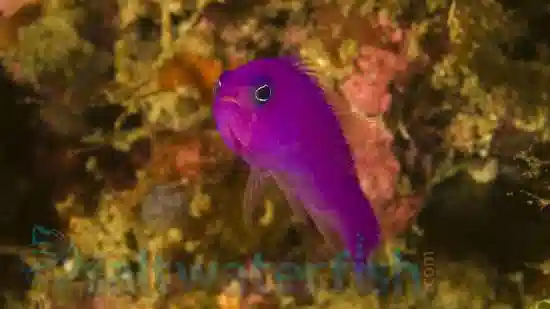Purple Dottyback
Pictichromis porphyreus
(0 Reviews)
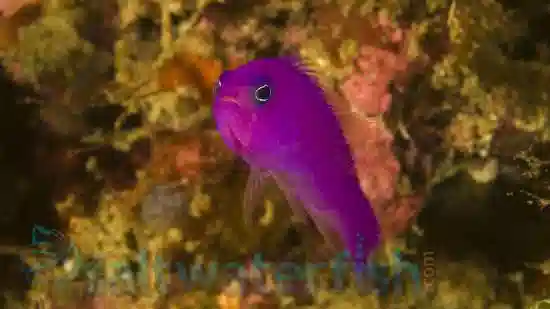
Purple Dottyback
Pictichromis porphyreus
(0 Reviews)
{{ item.name }}
Size: {{ item.extra_field_3 }}
${{ getFormattedPrice(item.saleprice) }} ${{ getFormattedPrice(item.price) }}
To join the waiting list, click here
Free Shipping
With
$199.00
or more in Marine Life.
More details...
Purple Dottyback Care Facts
| Care Level: | Easy |
|---|---|
| Temperament: | Semi-Aggressive |
| Diet: | Carnivore |
| Origin: | Indo-Pacific Ocean |
| Acclimation Time: | 2+ hours |
| Reef Safe: | Yes |
| Minimum Tank Size: | 30 gallons |
| Max Size: | 3 inches |
Keeping the Purple Pseudochromis (Pictichromis porphyreus) in Your Saltwater Aquarium
The Purple Pseudochromis, scientifically known as Pictichromis porphyreus, is a fascinating and colorful addition to saltwater aquariums. In this comprehensive guide, we will provide essential information on successfully caring for Purple Pseudochromis, including insights into their habitat, reef compatibility, size, lifespan, dietary needs in captivity, availability through aquaculture, compatibility with other marine species, sexual dimorphism, changes in coloration from juvenile to adult stages, temperament, specific tank requirements, and precise water conditions. We will also list common names for this species and explain why acquiring Purple Pseudochromis from Saltwaterfish.com is a wise choice.
Habitat and Natural Range of the Purple Pseudochromis
Purple Pseudochromis are native to the Western Pacific Ocean and commonly found in Fiji and Tonga waters. They inhabit rocky reefs and coral outcrops, seeking shelter in crevices and small caves. In your aquarium, it's essential to replicate this natural habitat by providing ample hiding places among live rock and coral formations.
Reef Compatibility of the Purple Pseudochromis
Purple Pseudochromis are generally considered reef-safe, making them suitable for reef aquariums. They typically do not harm corals or invertebrates. However, like many saltwater fish, their compatibility largely depends on individual temperament and the specific combination of species in your tank. Always monitor their behavior when introducing them to a reef environment.
Size and Lifespan of the Purple Pseudochromis
Purple Pseudochromis typically grows to a modest size, reaching an average length of 3 to 4 inches (7.62 to 10.16 centimeters). In a well-maintained aquarium, they can live for several years, up to 5 to 7 years.
The Diet for the Purple Pseudochromis
Purple Pseudochromis feed on small crustaceans, zooplankton, and tiny invertebrates in their natural habitat. To ensure their health and vibrancy in captivity, provide a balanced diet consisting of the following:
- High-Quality Marine Pellets and Flakes: These should be a staple in their diet, as they offer essential nutrients and can be easily consumed.
- Live and Frozen Foods: Supplement their diet with live or frozen offerings such as brine shrimp, mysis shrimp, and finely chopped seafood. This variety mimics their natural feeding habits and provides essential nutrients.
- Occasional Small Live Prey: Purple Pseudochromis may occasionally accept small live prey, such as copepods and amphipods.
Aquaculture and Availability of the Purple Pseudochromis
Aquacultured specimens of Purple Pseudochromis are occasionally available to hobbyists. Acquiring aquacultured individuals can benefit both the fish and the environment, as it reduces pressure on wild populations and often results in hardier, disease-resistant specimens. If aquacultured specimens are unavailable or suitable for your requirements, choose responsibly collected wild-caught specimens.
Compatibility of the Purple Pseudochromis with Other Fish and Invertebrates
The Purple Pseudochromis is generally peaceful, making it compatible with other marine species. When selecting tank mates, consider the following factors:
- Compatible Tank Mates: Opt for species that are not aggressive or overly territorial, as Purple Pseudochromis prefer a tranquil environment.
- Size Considerations: Be cautious about pairing them with significantly larger or aggressive fish that may intimidate or harm them.
- Invertebrates: Purple Pseudochromis are typically safe around corals and invertebrates, but individual behavior can vary.
Sexual Dimorphism of the Purple Pseudochromis
Purple Pseudochromis do not exhibit strong sexual dimorphism, which means that males and females share similar physical characteristics. Distinguishing between the sexes based on appearance is challenging.
Juvenile to Adult Coloration Changes of the Purple Pseudochromis
Juvenile Purple Pseudochromis often have a lighter, pinkish-purple body with a contrasting bright yellow tail. Their coloration intensifies as they mature into adulthood, with a deep, rich purple or violet body. This striking transformation adds visual appeal to your aquarium.
Temperament of the Purple Pseudochromis
Purple Pseudochromis are known for their curious and inquisitive nature. They are active swimmers and enjoy exploring the nooks and crannies of your aquarium. While they are generally peaceful, some individual variation in temperament can occur. Observing their behavior and monitoring their interactions with tank mates is essential to ensure compatibility.
Tank Requirements
To create an ideal environment for Purple Pseudochromis, consider the following tank requirements:
- Minimum Aquarium Size: A minimum tank size of 30 gallons is recommended to provide sufficient space for them to swim and establish their territory.
- Aquascape: Provide plenty of live rock structures, caves, and hiding spots for these fish to seek refuge and establish territories.
- Tank Lid: Ensure your aquarium has a secure lid to prevent accidental jumps. Purple Pseudochromis are known to be occasional jumpers.
Water Conditions
Precise water conditions are essential for the well-being of your Purple Pseudochromis:
- pH Level: Maintain a stable pH level within the range of 8.1 to 8.4.
- Salinity: Keep salinity levels consistent at approximately 1.025 for optimal health.
- Water Temperature: Maintain a water temperature range of 74°F to 80°F (23°C to 27°C).
- Water Flow: Purple Pseudochromis prefer moderate water flow within the aquarium.
Common Names of the Purple Pseudochromis
The Purple Pseudochromis is known by common names such as Orchid Dottyback, Orchid Dottyback, and Magenta Dottyback.
Why Choose Purple Pseudochromis from Saltwaterfish.com?
Acquiring Purple Pseudochromis from Saltwaterfish.com offers several advantages:
- Healthy Specimens: Saltwaterfish.com is dedicated to providing customers with vibrant, well-acclimated Purple Pseudochromis, ensuring their readiness for aquarium life and contributing to their long-term well-being.
- Responsible Sourcing: By acquiring these fish from Saltwaterfish.com, you support responsible sourcing and ethical collection practices for marine species.
- Expert Guidance: Saltwaterfish.com offers expert guidance and support to help you provide the best care for your Purple Pseudochromis in your saltwater aquarium.
In conclusion, the Purple Pseudochromis (Pseudochromis porphyreus) is an attractive, peaceful fish that can be an excellent addition to your saltwater aquarium. Renowned for its mesmerizing coloration and inquisitive nature, these dottybacks are an excellent choice for marine enthusiasts. Choosing Purple Pseudochromis from Saltwaterfish.com ensures access to healthy specimens and expert advice for their successful care in your aquarium.
Very shy but active
Reviewed by: Bobbi Link on Dec. 15, 2024
Reviewed by: Roderick Seurattan on Nov. 19, 2024
So vibrant and beautiful !!
Reviewed by: Michael Mallard on Sept. 2, 2024
Reviewed by: Kayla Jesse on Aug. 29, 2024
Reviewed by: Jeffrey Bagley on Aug. 5, 2024
Ok
Reviewed by: David Grass on Aug. 5, 2024
Great specimen, instantly found its cave.
Reviewed by: Andrew Hayes on Aug. 4, 2024
Reviewed by: Paige Hutchinson on July 15, 2024
Reviewed by: Paige Hutchinson on July 3, 2024
Very healthy very colorful.
Reviewed by: Eric Brugman on May 8, 2024
Very nice and healthy
Reviewed by: Richard Kenney on May 6, 2024
Reviewed by: Scott Ross on April 19, 2024
O Amazing fish, brilliant coloring, curious and active as soon as he got into the quarantine tank has already learned to recognize me when it’s feeding time
Reviewed by: James Mauro on April 14, 2024
Reviewed by: Beau Delaporte on April 11, 2024
Gorgeous actually got what I wanted. 1 3inch 1inch and a half. One lives on it's side of the tank one on the other. Very beautiful healthy fish.
Reviewed by: Michael Pimental on April 3, 2024
Very bright, larger fish sent. Looks great.
Reviewed by: Shaun Huddleston on March 20, 2024
Very vibrant and colorful
Reviewed by: Shaun Huddleston on Feb. 15, 2024
Reviewed by: Edward A Wilburn on Jan. 12, 2024
Reviewed by: Erin Holmes on Dec. 17, 2023
Relly great. I put the 4 smaller in my 95 gallon tank. Haven't seen them since. put the 2 largen in m 65 gal tank saw both for a while yesterday just saw one.
Reviewed by: Gary Stennett on Dec. 14, 2023
Both I ordered seemed healthy and beautiful colors. Make sure if you have more than one to acclimate them separately or put in a divider or they might fight like mine did.
Reviewed by: Denise Nelson on Dec. 3, 2023
Reviewed by: Robert Pilny on Oct. 31, 2023


